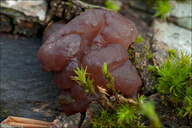date of photo Nov 18, 2013
latitude 46.35964 longitude 13.70142
View on Google Maps.
location
Lower Trenta valley, between villages Soča and Trenta, near 'Na melu' place, East Julian Alps (Posočje, Slovenia)notes Slo.: pecljata zamazanka - syn.: Tremella recisa Ditmar - Habitat: modestly southeast inclined mountain slope, mixed wood, dominant Fagus Sylvatica, Picea abies; overgrown calcareous ground composed of old alluvial and glacial moraine scree, rocks and boulders, relatively warm and dry place, in shade, partly protected from direct rain by tree canopies, average precipitations ~ 3.000 mm/year, average temperature 7-8 deg C, elevation 595 m (1.950 feet), alpine phytogeographical region. - Substratum: fallen Fagus sylvatica trunk; mostly still in bark in its late initial stage of disintegration. - Comments: Three sporocarps found growing close together; fresh fruitbodies pinkish-brown, oac651, after two days in refrigerator becoming olive-brown, oac734; fruit body dimensions up to 5 x 4 x 2.5 cm; clumps spreading flat over the substratum and attached to it only at isolated spots resembling rudimentary short 'stalks'; context quite firm, gelatinous; taste indistinctive, smell none; SP not obtained, only a few (12) spores have been found. This observation looks at macroscopic level like Exidia recisa, but microscopy doesn't confirm this determination. Spores (which may eventually origin from somewhere else?) do not fit expectations. I was also unable to find small, longitudinally septate, almost globose basidia, which are characteristic to this species (see Ref.: 3). The surface of the blobs looks like a hymenium with 'regular' basidia, however without sterigmata. Have no explanation. Hence, this determination can be wrong. - Spores smooth. Dimensions:9,4 [10,4 ; 11,2] 12,3 x 5,5 [6,1 ; 6,5] 7,1 microns, Q = 1,5 [1,7 ; 1,8] 1,9; N = 12; C = 95%; Me = 10,8 x 6,3 microns, Qe = 1,7. Olympus CH20, NEA 40x/0.65, magnification 400x, in water, Congo red. AmScope MA500 digital camera. - Herbarium: Mycotheca and lichen herbarium (LJU-Li) of Slovenian Forestry Institute, Večna pot 2, Ljubljana, Index Herbariorum LJF - Ref.: (1) Personal communication with Mr. Anton Poler. (2) http://www.mycoquebec.org/bas.php?post=Exidia&l=r&nom=Exidia%20recisa%20/%20Exidie%20obconique&tag=Exidia%20recisa&gro=109 (3) J.Breitenbach, F.Kraenzlin, Eds., Fungi of Switzerland, Vol.2. VerlagMykologia (1984), p64.camera Nikon D700/Nikkor Micro 105mm/f2.8
contributor's ID # Bot_776/2013_DSC9492 photo category: Fungi - fungi
|
